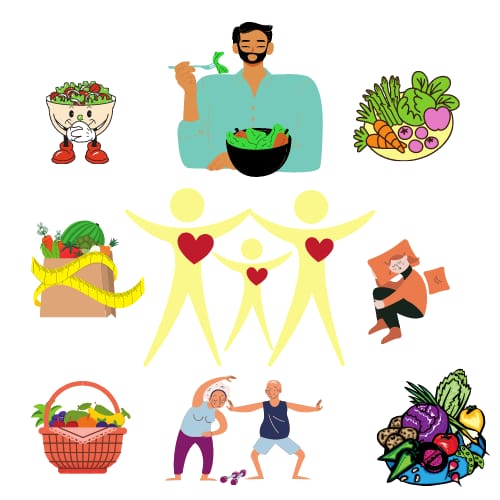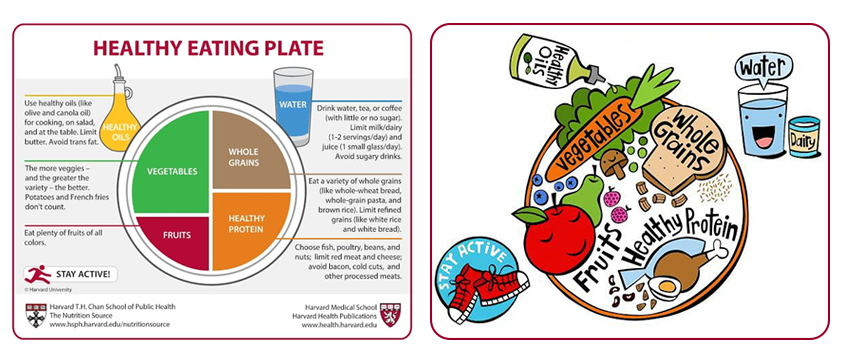
Eat Colors of the Rainbow
When it comes to consuming colorful produce, the more, the better! Vibrant fruits and veggies supply ample nutrients, including fiber and powerful phytochemicals that protect the body against oxidative damage. Throw spinach into smoothies, roast various squash assortments, snack on fresh blueberries, along with experimenting and trying out new foods.
1. Load your plate with vegetables.
Even the USDA has abandoned the confusing food pyramid in favor of a simpler “healthy plate” diagram. To build a healthy plate, fill half your plate with vegetables — and, no, French fries don’t count! Choose “crunchy” vegetables, such as broccoli, green beans, Brussels sprouts, and leafy greens like kale and Swiss chard. On the other side of the plate, put whole grains or legumes in one quarter and a serving of healthy, lean protein in the other.
2. Add, Do Not Subtract
Thinking about limiting and ridding foods poses negative thoughts and may hinder motivation for healthier eating. So rather than focusing on subtracting less-than-healthful foods, practice good eating by incorporating whole grains, fresh produce, lean meats, dairy products, and healthy fats. Increasing such foods can naturally reduce room for other fillers that tend to supply nothing more than calories, sugar, fat, and salt.
3. Stray Away from Calorie Counting
Although calorie counting is valuable for individuals to understand and track foods consumed, calories are just a small portion of the health equation and may not totally be worth your efforts and stress. Rather than fixating on calories, focus attention on whole foods. Healthier eating naturally takes care of calorie counting, without the need to tally them up on your end, while supplying the body with nutrients it needs.
4. Have A Game Plan
Ordering off a menu or shopping at the grocery store can be dangerous territories, especially when hunger strikes and all foods look tempting. Having a game plan by formulating a grocery list or looking at the menu prior to dinner can reduce the risk of impulse buys and orders.
5. Eat Flavorful Foods
Individuals tend to perceive “diet” food as lacking flavor and dull, being less to be desired, and increasing the temptation of others. However, nutrient-rich foods can also be packed with flavor with the use oils, herbs and spices.
6. Meal Prep
“Fail to plan and plan to fail” holds much truth when it comes to good eating practices. Meal prepping encourages individuals to organize weekly meals in hopes to reduce temptations of after work drive thru runs. Find a beginner’s guide to meal prepping guide to meal prepping here, along with recipes and ideas.
7. Snack
While snacking may be a habit you already implement, it may deserve some thoughtful modifications. Snacking can actually be a healthy eating habit, especially when consuming snacks ample in fiber and protein, as it may help lessen the risk of overeating come mealtime. Healthful snacks include veggie slices and hummus, banana and peanut butter, and berries and Greek yogurt.
8. Implement Mindful Eating
Mindful eating is a rising approach for both physical and mental health, as it helps nurture the body and strengthen relationships with food. The practice focuses on eating intuitively, monitoring hunger and satiety based on body cues and appreciating the taste and smell of nourishing foods.
9. Drink Water
Drinking more water also follows the “add, not subtract” rule, especially when trying to reduce soda intake. Keeping hydrated is imperative for the body to carry out numerous physiological processes, helps improve digestion, and may assist in weight loss and maintenance. Healthy adults should aim for at least eight, 8-ounce glasses of water per day.
10. Eat Your Calories and Nutrients
Food should be the number one source of calories and nutrients. Drinks, especially sugary ones and alcohol, may not only pack on empty calories, but does so quickly. Nutrition experts encourage people to eat their calories, rather than drink, to help ensure nutrient content and naturally keep calories in check.
11. Chew your food
One of the easiest and obvious ways to digest food is to chew it. Most people often eat their food in a hurry and skip chewing their food properly. While what you eat eventually gets digested, but a barely chewed morsel takes more time and tires your digestive system. Besides, the more you chew your food, the easier it becomes for your stomach to digest it and the more calories you burn moving your jaw. Small steps like learning to chew correctly go a long way in forming a healthy food habit.
12. Focus on your food
Most of us have our food while texting or watching television and don’t really keep a count of how much we end up eating. Though your stomach might be full, your brain tells you to eat more, and you eventually end up overeating. If you focus only on your food then you’ll eat only as much as your body requires. So, the next time you sit down for your meal, keep the remote control and mobile phone away for some time.
13. Boost your digestion
While knowing what to eat and how much to eat is important, it always helps if you can boost the process of digestion. Sitting in Vajrasna (adamantine pose) for a few minutes after having food helps you there. This yogic posture enhances blood circulation in the lower abdomen and improves the digestive process.
Protip: Consume pre- and probiotic supplements (after consulting with a food expert). A prebiotic creates a good environment for the good bacteria in the stomach. You can add many more of the good bacteria with the regular consumption of a probiotic.
14. Switch to whole grains
When it comes to carbohydrates, brown is better. Whole-grain foods (like whole wheat, brown rice, and oatmeal) contain more nutrients and fiber than their processed white cousins. Not only are these complex carbohydrates healthier for you (higher fiber intake has been linked to reduced risk of diabetes and heart disease), but they also help keep you full longer. So instead of shunning carbs in an effort to lose weight, start by swapping out the white ones for whole grains.
A good food habit helps shape your personality Remember – what you eat is what you become. So, adopt good eating habits, choose wisely and develop healthy food habits.
Enjoy your food.
This may sound obvious, but many people think that healthy eating and enjoyment are mutually exclusive. Pretend you never heard the word “diet.”‘ Instead, work toward a lifestyle built on healthy choices that are going to work for the long-term. In order to achieve that goal, find nutritious foods that you enjoy eating. Food should be something you relish and that nourishes you. It’s not just fuel.


